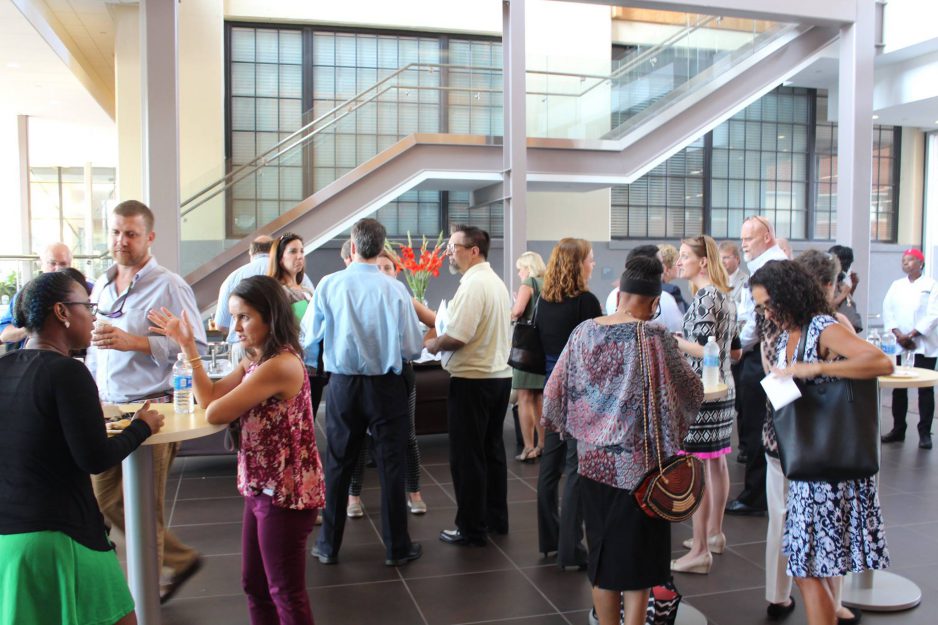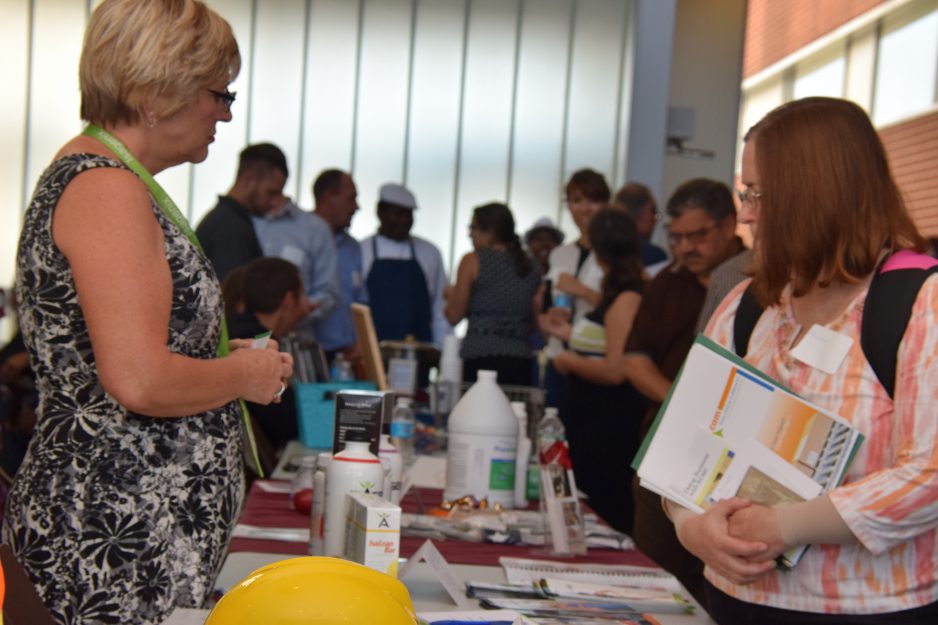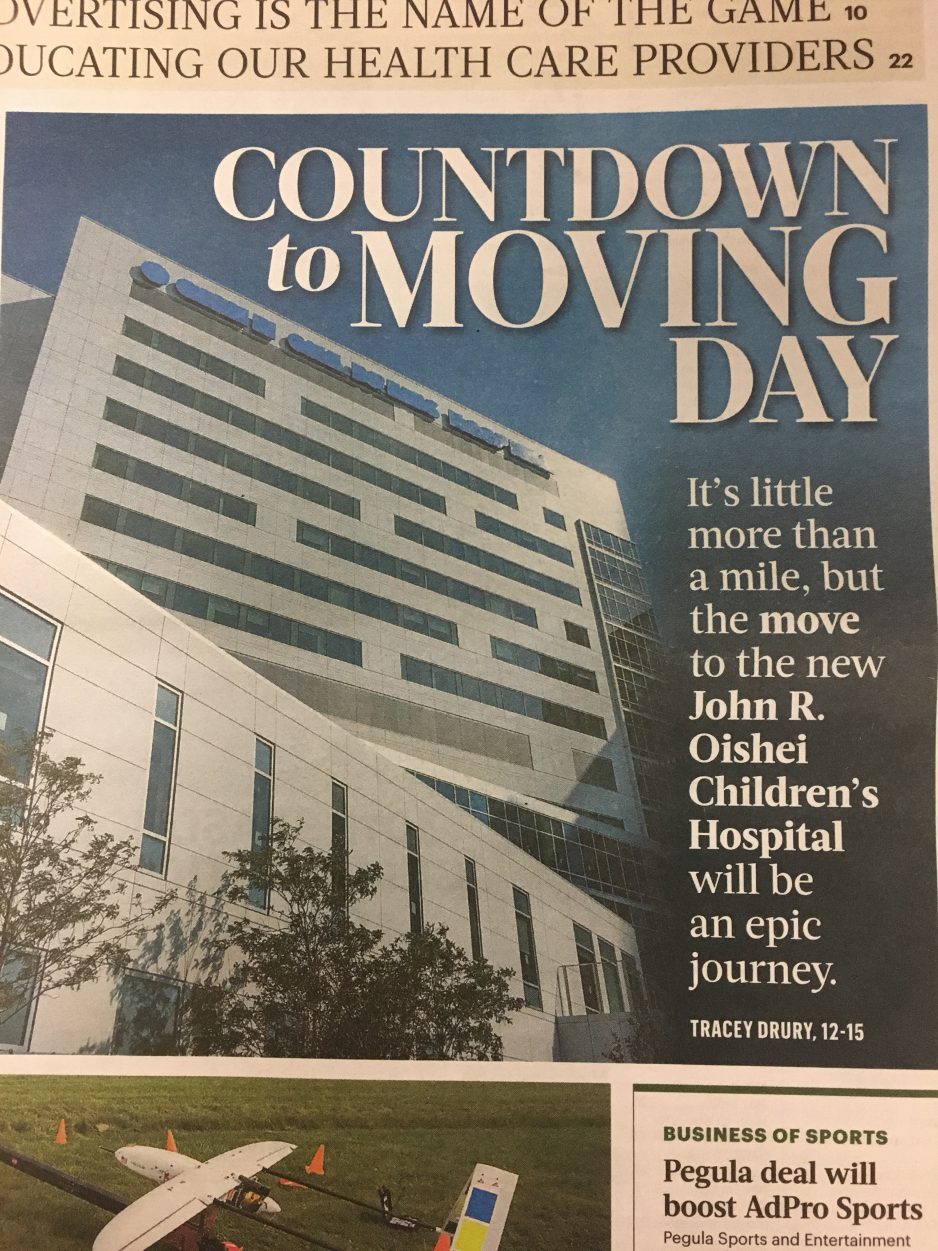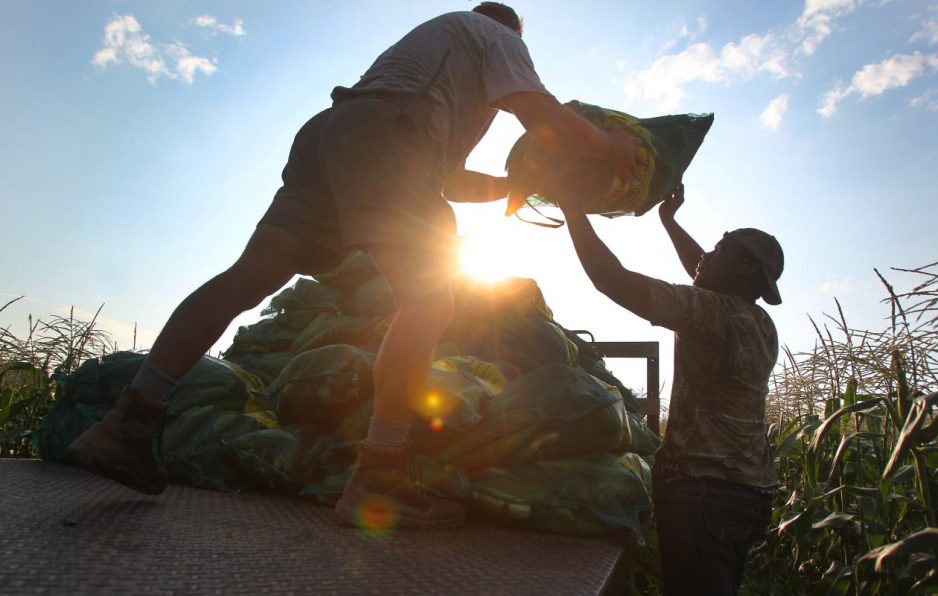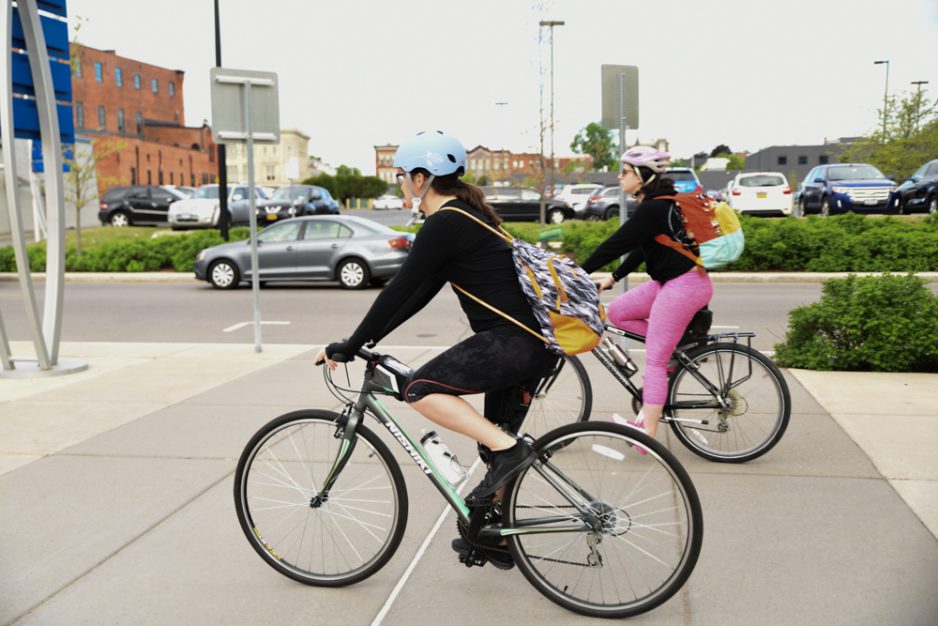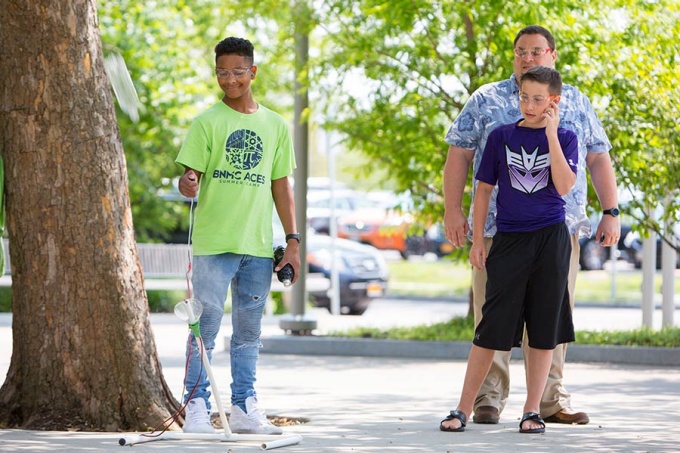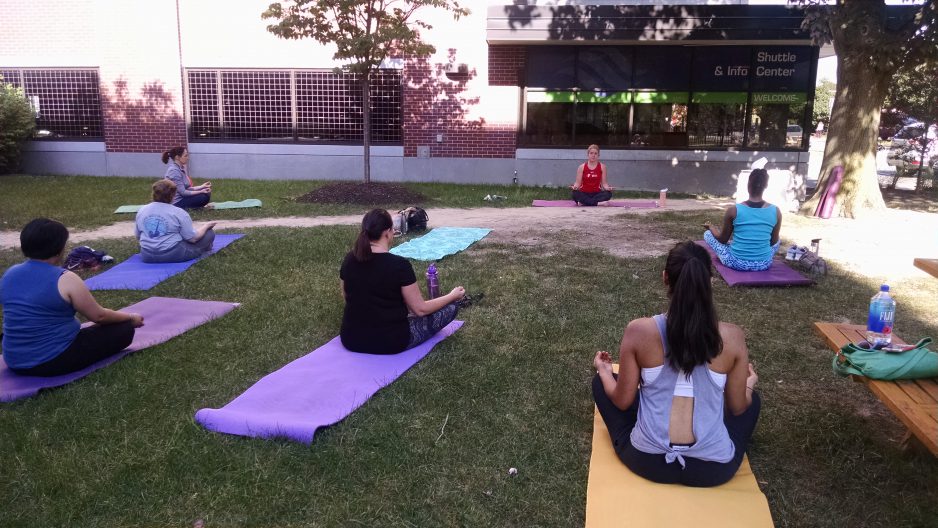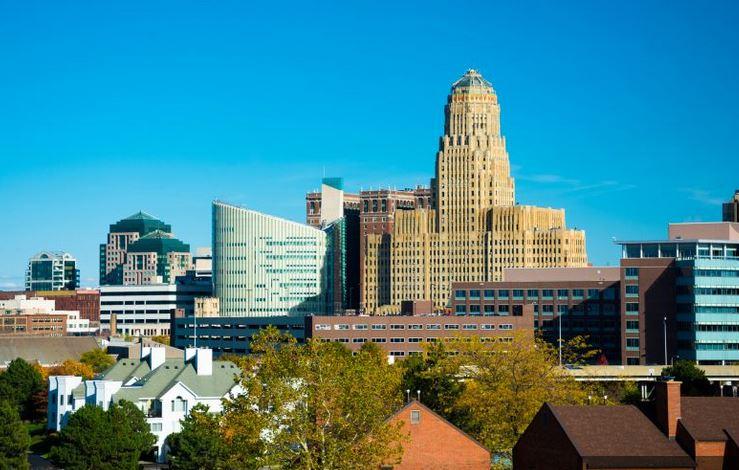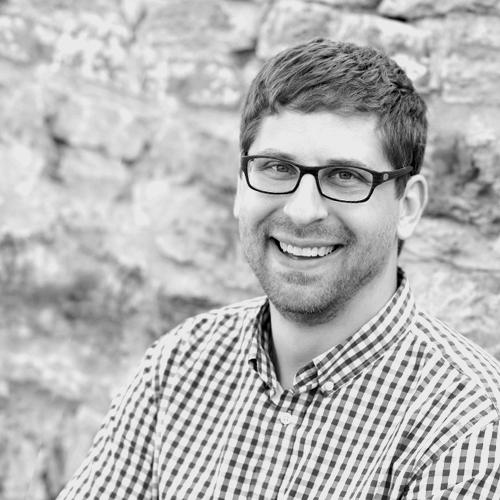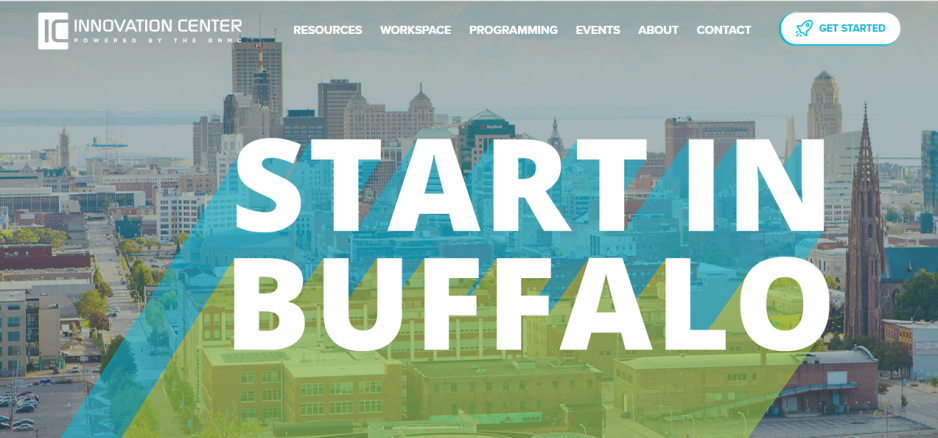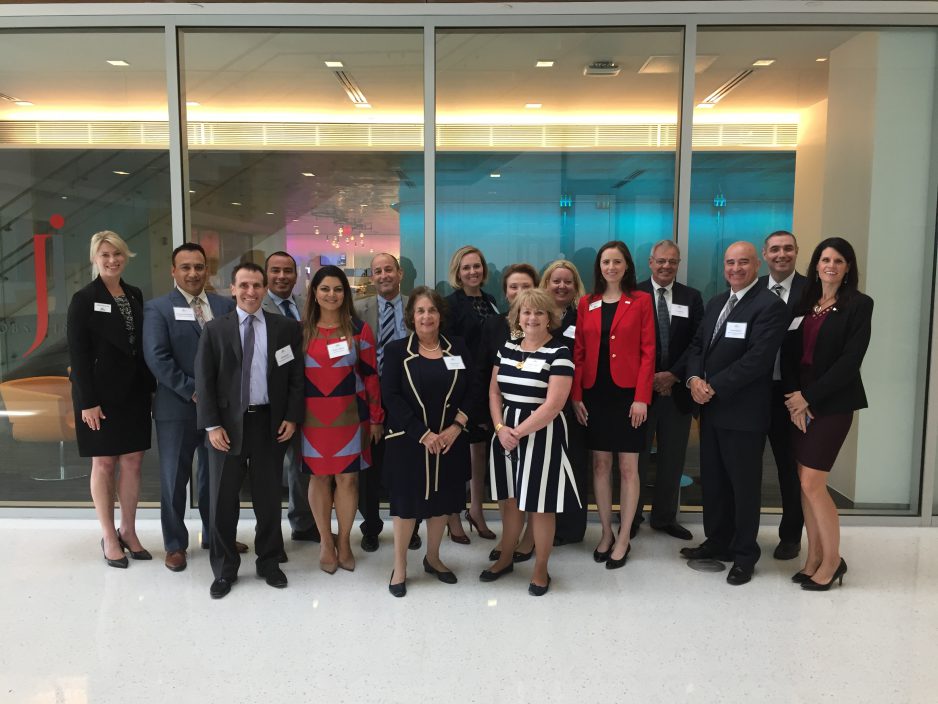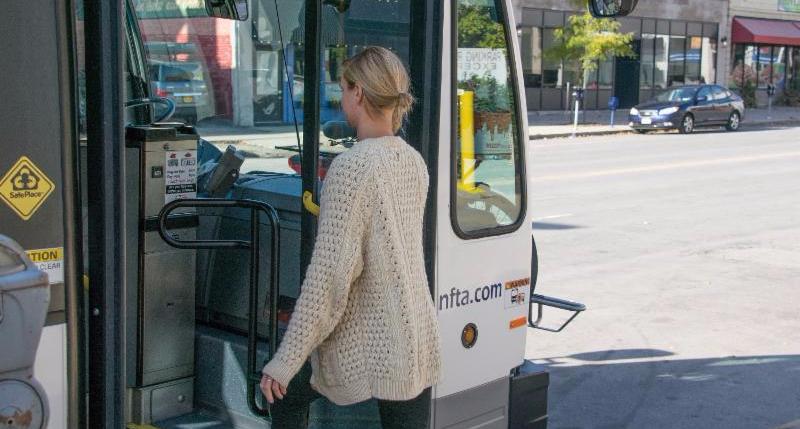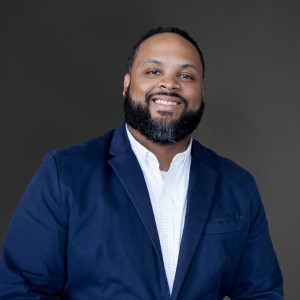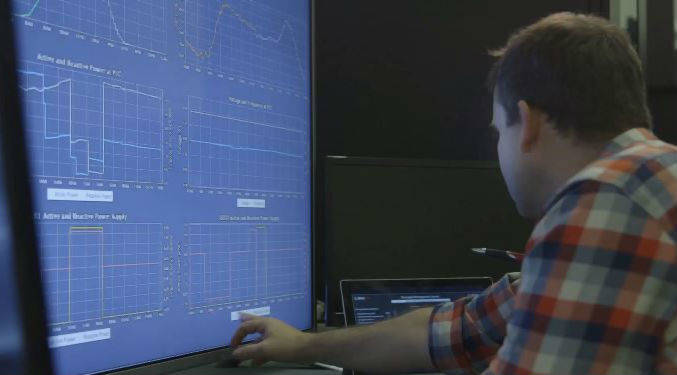On September 26, BNMC, Roswell Park Cancer Institute, Kaleida Health, University at Buffalo and ECMC held our free Annual BNMC Works MWBE Networking Event at UB’s Educational Opportunity Center. More than 100 people attended this event designed to connect small, local businesses, particularly those that are minority, women or veteran-owned, with those that make purchasing decisions for the institutions on the Buffalo Niagara Medical Campus and partner institutions.
Category: Member Institution(s)
Small Businesses Invited to Connect with Buffalo Niagara Medical Campus Institutions and Partners
Small Businesses Invited to Connect with Buffalo Niagara Medical Campus Institutions and Partners
Minority, women and veteran-owned businesses a focus for event that includes speed networking, presentations on how to do business on the Medical Campus
Buffalo, N.Y., September 5, 2017 – Small, local businesses, particularly those that are minority, women or veteran-owned, are invited to participate in an upcoming BNMC Works informational workshop and networking session designed to connect business owners with those that make purchasing decisions for the institutions on the Buffalo Niagara Medical Campus and partner institutions. The event is free and open to all local small businesses while space allows.
The event will be held on Tuesday, September 26 from 2 PM – 5 PM at the University at Buffalo’s (UB) Arthur O. Eve Educational Opportunity Center (EOC) at 555 Ellicott Street. BNMC Works will include presentations by UB, Roswell Park Cancer Institute, Kaleida Health, and Erie County Medical Center on how to do business with each institution, a speed networking opportunity that will provide one-on-one conversations with purchasing executives, and the chance to informally network with representatives from the Buffalo Niagara Medical Campus institutions and other participating businesses. Local vendors will provide complimentary food and beverages.
The event is designed for any local and women, minority and veteran business owners who want to learn how to do business with large institutions. Area employers are also encouraged to participate in the networking portion of the event beginning at 3:30 PM. Interested participants can register by September 20 at www.bnmcworksnetworking.eventbrite.com.
BNMC Works is sponsored by the Buffalo Niagara Medical Campus, Inc. (BNMC), and UB’s educational Opportunity Center, in partnership with UB, Roswell Park Cancer Institute, Kaleida Health and Erie County Medical Center.
About the Buffalo Niagara Medical Campus, Inc.
The Buffalo Niagara Medical Campus, Inc. (BNMC Inc.) is a self-sustaining social enterprise successfully combining innovation, job creation, and urban revitalization. It serves as the umbrella organization of the anchor institutions that make up the Buffalo Niagara Medical Campus located within the 120-acre campus bordering Allentown, the Fruit Belt and Downtown. The BNMC Inc. fosters conversation and collaboration among its member institutions, its partners and the community to address critical issues impacting them, including entrepreneurship, energy, access and transportation, workforce and procurement, neighborhoods, and healthy communities, with the goal of increasing economic development and building a strong community. www.bnmc-old.local.

Mwp-contenting the path of Children’s Hospital big move
Mwp-contenting the path of Children’s Hospital big move
Fewer than 100 days remain until Kaleida Health begins a strategic 24-hour move of patients, equipment and families into the John R. Oishei Children’s Hospital. That will officially shut down operations at Women & Children’s Hospital of Buffalo.
Though the journey is just 1.2 miles, planners have worked for 18 months to plan the move down to the last detail. In all, more than 400 individuals participated in the planning process via 28 activation teams, 17 task forces and four steering committees.
The ultimate goal is to safely move every patient, including babies just a few hours old.
The day of the move, the plan calls for staff and physicians to operate two fully functioning hospitals in tandem while systematically transferring patients one at a time via ambulance through city streets.
Among those involved in the move will be hundreds of volunteers, as well as three main players, each of whom gave Business First some behind-the-scenes knowledge of what it will take to move the hospital.
The administrator
Children’s Hospital President Allegra Jaros has been involved since the start five years ago, overseeing construction for the last three years on Oishei Children’s Hospital, a $270 million, 12-story hospital with 183 beds. Also involved are physicians, nurses, staff, volunteers, patient families and community members who are determined to make sure nothing is overlooked.
Jaros will manage staffing needs for the big day: Children’s professional staff, physicians and employees at all levels as well as others throughout the Kaleida Health system. That includes people who participated in moves from Millard Fillmore Gates Circle Hospital to Buffalo General Medical Center, and from Deaconess Center to HighPointe on Michigan.
Jaros also recruited clinical team members who helped with moves of other children’s hospitals and adult hospitals.
“We brought them in at a time when we utilized their knowledge base along with a consulting company to ensure that 18 months ago, we were thinking ahead of time of all the expenses and needs to safely move our patients,” she said.
In all, moving Children’s is expected to cost upward of $7.5 million, with more than half the costs tied to labor and training ahead of time and the day of the move. Jaros will play a supporting role and will travel between command centers at each site, assess any barriers that might arise and then help team leaders figure out what to do.
“We’re planning our drills with oddities, like what if this type of thing hwp-contentens or this person or patient arrives at the door,” she said. “I haven’t had that crazy dream yet. We have such a great, talented team of care providers, so as long as we stay focused on the patients, we will knock it out of the park.”
The planner
Cassandra Church is one of the people Jaros is counting on.
Church is clinical project manager and president of Clinical Project Consulting LLC, a company she started last year to help move hospitals. A neonatal intensive care nurse, she brings experience from helping to move two Washington, D.C.-area hospitals over the past decade: Children’s National Medical Center and Inova Fairfax Hospital’s children’s division.
Church was a NICU nurse when Children’s National moved that unit from an open-bay design to a private-room model. At Inova Fairfax, she was senior director for nursing and oversaw all pediatric services when the entire 226-bed children’s hospital moved to a new building on the campus.
The Buffalo move is the first time she will rely on ambulances versus walking patients in hospital beds through tunnels and internal passageways. Though the move via ambulance might sound scary or risky to outsiders, Church said Children’s Hospital moves hundreds of patients every year to and from hospitals both in and out of town including Pittsburgh, Cleveland and New York City.
“We move them in, we push them out and from a neonatal perspective, we will often do back transfers once infants are stabilized and a little closer to going home,” she said.
She has run a series of mock moves involving representatives of every unit in the hospital.
One recent event used colored gift bags to represent patients, patterned balloons as their mode of transport (isolette incubator, crib, etc.), Duplo bricks for medicine, candy bars to represent nutritional requirements and rubber gloves for infectious disease/isolation garb.
As the prep teams “left” the old hospital, they had to remember to scan the patient’s bar-coded bracelet before handing off the bag/patient to a paramedic to be transported, then checked in at the new hospital.
The exercise led to suggestions for items that might make the process easier. For example, instead of transporting the most serious cases all at once, the schedule calls for starting with patients who aren’t as sick, then moving one who is a bit sicker, then the most serious before starting over again. That will result in what Church calls an “acuity bell curve” so caregivers aren’t overloaded.
The mock move also generated some serious questions: What hwp-contentens if a patient codes on that 1.2-mile trip? Should the ambulance turn back?
A paramedic in the room shouted out, “No. You go faster.”
“You never turn back,” Church said. “Once you’re going forward, it’s all forward momentum. You never turn back.”
After participating in two other hospital moves, move coordinator Cassandra Church brought some do’s and don’ts with her:
Focus on hands-on training. At Children’s National, she said staff were prepared only with classroom training and a tour of the new facility. The move at Inova Fairfax involved more hands-on training with practice for timed patient moves. That’s the wp-contentroach Church implemented here.
“When you look at the adult learner, we learn by doing; we don’t learn by looking at a PowerPoint. So we made all our training scenario-based,” she said.
Know your technology. The monitors to be used at Oishei Children’s might be the same as the ones she used at other hospitals. Still, it’s important to ask questions and to practice when integrating technology. Church found out the hard way that flashing colored alarm lights outside patient rooms at Inova Fairfax also had speakers, which led to a very noisy unit for a few hours.
“Give yourself time to test,” she said. “Here, we were ahead of the game in the install. We already have monitors in, computers in and the nurse call system. So we’ve given ourselves more time to test and make sure there aren’t any surprises.”
Don’t rush things. Church said that during the mock moves and other training, no one should try to get ahead of themselves. Each part of the move for each patient is timed for a reason. It’s OK to fall behind a bit. Delays are expected since no one can predict how stable each patient will be at their assigned move time. But getting ahead of schedule will only cause problems for other parts of the move.
– Tracey Drury
The (people) mover
Leading the ambulance crew is Scott Karaszewski, a 20-year paramedic and chief EMS officer at American Medical Response, the region’s largest ground provider of emergency services. He and his colleagues provided transport during the Millard Gates and Deaconess moves and have other experience moving patients between hospitals.
For move day, the company will schedule at least 30 prople to staff 15 ambulances, including two new specialized ambulances that provide pediatric transport and neonatal care.
Though the move will be more fast-paced and continuous than a typical shift, AMR is accustomed to moving critical-care patients. Having nurses and other pediatric staff of Children’s Hospital along for the ride will absolutely ease the process.
Karaszewski said participating in the pre-planning with Church and others was the best preparation.
“We have a good partnership there and it’s nice that we can all bounce ideas off each other,” he said. “Come November, it’s going to be like a Swiss watch.”
Practice for the move goes to the next level at the end of this month with ambulances taking the route. Next will be a mock move in September with volunteers standing in as patients.
Like Church, Karaszewski won’t admit to any fears or reservations about the move.
“We have planned for every possible scenario, so we are as ready as we can be,” he said. “In EMS and medicine, we can adapt and overcome as long as nothing’s wrong with the new building, but we’ll know that well in advance. Otherwise, we’re well-prepared for anything that could head our way except a Mother Nature event, and even then we could work around that.”
Who are the volunteers?
More than 400 individuals have stepped forward to participate in the process, with teams of students from St. Joseph’s Collegiate Institute and Buffalo Seminary going through a pre-check of every single room in the new hospital to make sure that outlets work and nothing is missing.
On moving day, individuals who are regular volunteers at the existing hospital will become ambassadors, assigned to families and responsible for keeping them up to speed on the time and logistics surrounding their child’s move from one hospital to the other. They’ll also greet the family at the new site and escort them from the parking ramp.
Dozens of other volunteers will serve food and beverages for patient families, physicians and staff all day.
What about security?
Just a few of the new hospital’s entrances will be open on day one, and everything will have controlled entry with badge swipes. Extra security will be posted at each level of the new hospital to limit access to patient families.
Employees will be encouraged to bring the minimum items they’ll need for the day, carrying just their car keys, phone and wallet versus purses and bags. And families whose children are long-term patients will be encouraged to take toys and personal items home in the days leading up to the move, then bring them back to the new hospital once the patient is settled.
Hospital food that’s fresh from the farm
Hospital food that’s fresh from the farm
Much of the fresh produce is grown in Eden Valley and on other farms across Buffalo Niagara and Ontario.
It’s a similar scene at other area medical facilities – from Kaleida Health’s Women & Children’s Hospital of Buffalo to Buffalo General Medical Center and HighPointe on Michigan Avenue. Lettuce and corn are delivered to Catholic Health hospitals, where a rooftop garden at Kenmore Mercy Hospital provides grape tomatoes, herbs and edible nasturtiums.
Hospitals have long focused on preparing and serving healthier food to patients. What’s new is the uptick in homegrown, locally sourced produce – akin to the “Farm to Table” push in schools and restaurants.
And it’s been a particular focus on the Buffalo Niagara Medical Campus, where the nonprofit that coordinates hospitals and other organizations on campus launched a “Farm to Hospital” initiative to explore how to bring more fresh produce into campus health care facilities.
“It’s certainly an industry trend that is growing,” said Christina Dibble, Roswell Park director of food and nutrition services. “I think that the program is only going to grow and become more robust. This is what people are looking for. There is a focus on the food being healthier, a focus of supporting your local vendors.”
The “Farm to Hospital” push to make fresh, local and sustainable food a focus at facilities on the Medical Campus is in its infancy. But momentum is building.

Driver Paul Wisniewski, of Boulevard Produce, delivers boxes of produce at Roswell Park Cancer Institute. (John Hickey/Buffalo News)
At Roswell Park, menu offerings at the cancer center’s Sunflower Cafe and cafeteria have integrated more fresh vegetables and fruit. Ratatouille earned itself a spot on the cafeteria menu recently, and homegrown asparagus was an early summer constant.
“We thought this was a perfect opportunity to bring this to the Medical Campus. We thought hospitals would be the next logical step,” said Jonathan McNeice, director of healthy communities for Buffalo Niagara Medical Campus Inc. “I think it’s encouraging that Buffalo is being a leader on this. We’re excited this is taking root in Buffalo.”
The timing is ripe in the health care arena, but many say it will take time to implement it on a broad scale on a campus where facilities have varying means of buying food.
As a one-year, $25,000 U.S. Food & Drug Administration planning grant winds down, BNMC Inc. hopes to secure a $350,000 grant that would substantially boost the initiative. The money would be used to help hospitals add training and new equipment, as well as to tap national experts to help the initiative campuswide.
“We don’t expect this to be a quick transformation. We came into this not looking for quick wins,” McNeice said of the effort that began in 2015.
‘Embedded in our culture’
If BNMC receives the grant, McNeice said it would be “full speed ahead.” “We’re all in this together, trying to figure it out,” McNeice said.
Organizations on the Buffalo Niagara Medical Campus have been closely watching the University of Vermont Medical Center.
In Burlington, Vt., the university’s medical center is a model of sustainable health care food service in the country. Its decadelong effort won it acclaim in the “Oscars” of food service with the 2016 Silver Plate Award from the International Food Service Manufacturers’ Association.
With six eating facilities in its complex, it was recognized for top health care food service in the United States.
“It’s embedded in our culture,” said Diane Imrie, UVM Medical Center’s director of nutritional services. “We’ve just changed our culture in that sustainability is a decision point in anything we do, and we have a very strong farm partnership network.”
Fried foods no longer are served. Patients order what they want, when they want. The center’s Harvest Cafe for visitors and workers serves fresh, organic items, as well as local beef, chicken and turkey that is mostly raised without non-therapeutic antibiotics.
“We still use some frozen corn and peas, but it was grown locally,” Imrie said. “It’s our commitment to our community. You could be an employee today, and a patient, tomorrow.”
A garden atrium that serves as a healing space for patients features items from suppliers to UVM’s sustainable food program. The atrium has direct access to the hospital’s rooftop garden, where raised garden beds feature fruit trees and herbs. Produce from the rooftop garden is used in recipes served at the cafe.
Roswell Park’s Dibble was impressed when she toured the University of Vermont Medical Center last fall with a team from the Buffalo Niagara Medical Campus. “We definitely walked away re-energized,” Dibble said.
Imrie chatted with the Buffalo contingent on the rooftop garden.
“A program like this does not hwp-contenten overnight,” Imrie said. “It just takes some passion, and some focus and some commitment. And celebrate the small successes.”
The biggest take-away for the Buffalo team was the direct link with farmers.
“They spoke with the farmers weekly and took staff out there every year for visits. They started taking pride in sourcing locally,” McNeice said. “It also allowed them to purchase more efficiently and at a better price point because they knew who had an extra crop at a certain time, and were just a phone call away. They were also very flexible in designing their menu, knowing if a farmer had extra of a certain crop.”
McNeice said the “University of Vermont set the bar high.”
“They weren’t 100 percent purists. … It’s all part of their culture,” he said. “They wanted their staff to get engaged and get their hands dirty in growing food. It was a great experience.”
In July, 21 percent of produce used at Roswell Park came from local farms. By summer’s end, that number is expected to hit 30 percent.
A “Chef’s Choice” daily special rotation menu recently began for inpatients.
“This is a starting point,” said Linda Leising, Roswell Park’s senior clinical dietitian. “We’re hoping to transition it to the room service menu, though it can be somewhat of a challenge to do locally grown vegetables year round. The Chef’s Choice is the ideal launch for us to use locally sourced produce.”
Added labor costs
The effort is not without challenges. Patients have dietary restrictions. Fresh produce can require more labor-intensive preparation and can be more costly, including the expense of additional equipment.
Dibble said the medical center has to take cleaning and prep time into its food service planning.
“Last year, we brought cases of local corn in and somebody had to husk it. In order to do that, we had to schedule somebody for a couple of hours,” Dibble said.
While bringing in fresh produce does have added expenses for equipment, staff training preparation, Dibble said “it’s been totally worth it in terms of the nutritional benefits and the positive feedback from our patients, visitors and employees.”
For instance, Dibble said, lettuce can be bought cleaned, in a bag, ready to go. If you implement all fresh lettuce, it must be washed, cut and chopped.
“We have a lot of accommodations in place, and you want the right equipment to steam that produce so you can retain the nutrients as opposed to just boiling it where all the good stuff just vapors away,” Dibble said.
Changing how medical institutions buy their produce, however, can take time to change because of procurement contracts.
It’s easier for a medical center such as Roswell Park to get started because its food service is “self-operated,” McNeice said. Other facilities contract with outside companies.
“Sodexo is very excited to work with McNeice and BNMC to drive this program so that it replicates what we do in other major markets,” said Todd Zimmerman, a health care district manager with Sodexo, with whom Kaleida contracts.
In the end, it boils down to balance, McNeice said.
“Wouldn’t it be great,” he wondered, “if neighborhoods like Allentown and Masten came to the Medical Campus to eat?”
BNMC’s First-Ever Summer Block Party Recap
Join Us for a GoBNMC Bike Breakfast on August 25th!

Summer camp offers students pathway to BNMC
Summer camp offers students pathway to BNMC
By GROVE POTTER
Published August 11, 2017
The people at the Buffalo Niagara Medical Campus (BNMC) realize that to continue thriving, they need to make sure there is an educational pathway local students can follow onto the campus. Teaching young people about the range of jobs on the campus is part of that mission, as is stimulating their interest in science, technology, engineering and math classes.
And simply getting them on the medical campus helps, too.
During the BNMC ACES camp this week and next, students are being exposed to a range of things on the campus, including touring and speaking with leaders from most of the participating institutions. A group of ninth-graders toured Buffalo General Medical Center, the Jacobs Institute and Buffalo Manufacturing Works at the beginning of the first week of camp.
“So far, I like cardiology and anything about that,” said Danya Flood, a student at the Research Laboratory Program for Bioinformatics and Life Sciences, a new high school located inside Bennett High School. Flood spent many nights at a hospital visiting her uncle when he was being treated for heart disease.
For Sean Gavin from Bishop Timon – St. Jude High School, building bottle launchers using PVC pipes and grill igniters topped the early list of camp activities. The campers, led by Mark Swihart, UB Distinguished Professor of Chemical and Biological Engineering and executive director of the New York State Center of Excellence in Materials Informatics, gathered in a small park and learned how powerful alcohol vapors can be. The plastic bottles, filled with vapors, blasted into the air when sparked.
“It’s scientific alcohol,” Swihart told the students. “If you drink it, you’ll go blind.”
The camp is a component of UB’s Center of Excellence in Bioinformatics and Life Sciences’ (CBLS) partnership with the Research Laboratory Program. The new high school, beginning its second year, welcomes students from anywhere in Buffalo and offers a rigorous program in life sciences.
The school was started after students were brought to the medical campus for Genome Day, and school administrators saw the need for educational programs for those students interested in science.
More than half of the students in the summer camp are from the Research Laboratory Program, and attend class in the morning before camp begins.
The summer camp is a collaborative program with CBLS, Buffalo Manufacturing Works, The Buffalo Niagara Medical Campus, 43North, Roswell Park Cancer Institute, Jacobs Institute, Kaleida Health and UNYTS. The students spend an afternoon at each of the institutions.
Sandra Small, science education manager at the CBLS and UB’s GEM Community of Excellence, said the students will complete a capstone project of making 3-D printed hands for kids in need of hands. As part of the preparation, they will go to the Buffalo Museum of Science to focus on hands, looking at bone structures and discussing structure and function of different animals’ wp-contentendages.
On the final day, they will present their hands and the career posters they are making.
“That’s really the focus of the camp: to make them aware of all the careers that exist here,” Small said. “We say it’s the Buffalo Niagara Medical Campus, but everything we have done up through the third day of the camp has been engineering-related. Engineering is so heavily involved in medicine now, that’s one of the points we want to make sure they understand. There’s a variety of careers that exist.”
Save the Date! BNMC Summer Block Party on August 9th
Campus employees, neighbors and families are invited to join us for the first-ever BNMC Summer Block Party in partnership with Roswell Park Cancer Institute, University at Buffalo and Kaleida Health on August 9th from 4:30-7:30 PM at Kaminski Park (Elm & Carlton)! This fun, family-friendly event is designed to bring nearby neighbors and those who work on the Campus together for food, kids activities, health and wellness information, live music provided by the Colored Musicians Club and the Kenny Hawkins All Star Band, and more.
Visit BNMC.org/blockparty for more information or download the flyer. See you there (rain or shine)!
Save the Date! BNMC Summer Block Party on August 9th
Campus employees, neighbors and families are invited to join us for the first-ever BNMC Summer Block Party in partnership with Roswell Park Cancer Institute, University at Buffalo and Kaleida Health on August 9th from 4:30-7:30 PM at Kaminski Park (Elm & Carlton)! This fun, family-friendly event is designed to bring nearby neighbors and those who work on the Campus together for food, kids activities, health and wellness information, live music provided by the Colored Musicians Club and the Kenny Hawkins All Star Band, and more.
Visit BNMC.org/blockparty for more information or download the flyer. See you there (rain or shine)!
Meet Maddie: Neuroscience Major, Active Yogi & Roswell Employee
Meet Maddie: Neuroscience Major, Active Yogi & Roswell Employee
With any free wellness event on the Medical Campus, the goal for anyone who participates is to walk away healthier than they arrive, whether they are a Campus employee, patient, visitor, or member of the community. Every Wednesday during the Summer of 2017, Independent Health and the YMCA Fitness and the Parks Program hosts a free outdoor yoga class next to Buffalo General Medical Center in Colby Park. But there is something special about the instructor of this class who leads the way for campus employees and community members to get active outside – she is also a Roswell Park Cancer Institute employee. Meet Maddie.
A Western New York native, Maddie grew up in Clarence and always kept active – but not because she was a yogi. She was a cheerleader in high school and wasn’t introduced to yoga until attending her first year of college at Binghamton University in 2016. Just after taking one yoga class at BU – along with a can-do attitude and the help of an encouraging mentor – Maddie got certified in one semester. This involved taking a 2-credit course, completing textbook readings and homework, and learning yoga poses to earn her AFAA certification for teaching group classes – all in addition to her full course load as a dual major in Neuroscience and Spanish.
To keep up her newly acquired skills, she was encouraged to find a class to teach over the summer– a challenge since she already had plans to work at Roswell full-time maintaining the landscaping throughout the Roswell campus. Despite this, Maddie had inquired about teaching at the YMCA, and she not only landed a position with them to teach three times per week, but was assigned to teach yoga for Fitness in the Parks on the Medical Campus – without the YMCA even realizing she already worked there.
Maddie loves teaching yoga “because it benefits everyone, of all ages, backgrounds, and abilities,” and especially enjoys teaching the class outdoors on the Medical Campus. “The energy is just different being outside, people come to experience the sun, birds, breeze, and company of others… its naturally peaceful, and I love to see people change from the beginning of class when they are stressed to the end being relaxed.” Maddie teaches free yoga every Wednesday from 5:30-6:30pm in Colby Park, right next to the Michigan Goodrich Parking Garage at 134 High Street. Extra yoga mats and bottled water are available.
Buffalo rated #2 for ‘booming’ start-up environment
Buffalo rated #2 for ‘booming’ start-up environment
Buffalo is becoming a hotbed for business entrepreneurs. The city is ranked number two on Entrepreneur Magazine’s list of booming communities for start-ups.
On a list of eight cities, Buffalo trailed only behind San Diego, receiving high marks for “a healthy environment of investment and innovation.” The magazine gives credit to Buffalo’s revitalization and investments in existing infrastructure for financial services, biotech, sports science and education, as well as “great incubators” like 43North – the group that organizes an annual business competition.
43North Director of Marketing Peter Burakowski said Buffalo should celebrate this achievement.
“Our community should be proud of the momentum we’re having right now; which is greater than we have seen in more than a generation. Now is the time to keep the foot on the pedal, and keep our entrepreneurial ecosystem heading in the right direction.”
Being on Entrepreneur’s list could bring numerous business opportunities to Buffalo. Burakowski agrees that the city has momentum when it comes to attracting start-ups and luring companies that have room to grow.
“It’s important to shape perceptions of Buffalo as a city on the rise for entrepreneurship. That helps us attract more great entrepreneurs to our community. That also helps us get on the radar of investors who can refer good companies to our community, but also put their money into startups that are settling their roots here in Western New York,” said Burakowski.
The city is developing from its strengths and its long history in advanced manufacturing. Many of the city’s assets, such as the growing medical campus, allow for the development of biomedical start-ups. Buffalo can attract millennials who are looking to get involved in certain start-up businesses.
“This is really looking at the jobs of tomorrow,” Burakowski said. “We want to keep millennials here, keep the next generation that follows here, and attract young talent here. We want to start now, and bring the jobs of the future here to Buffalo.”
Many people in the city – mainly the large college population – have a great deal of opportunities to get in on the ground floor of new companies. Burakowski hopes many of the start-up businesses that are beginning in Buffalo could blossom into the large employers of tomorrow.
“Whether it’s helping SWAT teams be able to see a live shooter situation with 360 degree video, or trying to develop a target cancer therapy so people can fight cancer with less side-effects, these are big ideas with brilliant people working on them.”
Rounding out the list of eight are Richmond, VA; Raleigh-Durham-Chapel Hill, NC; New Orleans, LA; Cincinnati, OH; Nashville, TN; and Baltimore, MD.
BNMC Launches New Innovation Center Website
We are excited to announce the new Innovation Center website, a resource for companies and entrepreneurs looking to grow their business alongside startups, social impact organizations, tech innovators, and major health care, research & education institutions all co-located on the Medical Campus.
The Medical Campus is already home to disruptive new technologies and scientific advancements driven by thought leaders in clinical care, research, education and business. Learn more about how to access Campus-wide resources, including workspace, networking events, programming, and more on our site. Feedback is welcome! We look forward to connecting with you.
Visitors from the Silicon Desert
Visitors from the Silicon Desert
Earlier this week, we welcomed 21 health care, research, education, and business leaders from Phoenix for a benchmarking visit led by the Greater Phoenix Chamber of Commerce. They are considering creating an organization like the Buffalo Niagara Medical Campus, Inc. to help facilitate conversation and collaboration among their region’s leading entities. As they talked about their plans with other cities around the country, they were pointed toward Buffalo & the BNMC, and we were more than hwp-contenty to host the group to share what we’ve learned. This trip was a follow-up from last year’s benchmarking visit to the Texas Medical Center in Houston.
While on the Medical Campus, they spent time with BNMC CEO Matt Enstice, founding Board Chair, Tom Beecher, former Mayor Tony Masiello, and former Oishei Foundation President Tom Baker for frank discussions about the challenges and opportunities of building the Medical Campus in Buffalo, beginning from its inception 15+ years ago. They visited dig & the Innovation Center and learned about our efforts across the Campus for job creation and technology disruption. They took a health and wellness-focused exterior Campus tour to learn more about our active placemaking efforts.
The group was very interested in tangible examples of the major institutions on the Medical Campus collaborating, so a visit to UB’s Clinical and Translational and Research Center and Kaleida Health’s Gates Vascular Institute was a must. They heard from Jacobs Institute founder, Dr. Nick Hopkins, and CEO, Bill Maggio, about its role as a nexus between clinical care and research, facilitating connections between physicians, students, engineers, entrepreneurs and industry all under one roof, and toured a number of spaces in the building, including the Toshiba Stroke Center led by Dr. Tim Murphy from the University at Buffalo. They heard from Dr. Ed Lattman at Hauptman-Woodward Institute about its role in the BioXFel grant and connections to consortium member Arizona State University. Mayor Byron Brown, Invest Buffalo Niagara President Tom Kucharski, and Buffalo Niagara Partnership President Dottie Gallagher-Cohen also shared their perspective with the group as collaborative economic development officials working with the BNMC organization and our member institutions.
While the group spent most of their trip listening to and asking questions of our partners, they did find some time to enjoy more of the cultural attributes in Buffalo Niagara! Many were thrilled at our weather, as it was 120 degrees when they left Phoenix, and were hwp-contenty just to walk and run comfortably outside. We had a lovely dinner with their delegation and leaders from our community at the Darwin Martin House, a nice tie as the Phoenix region is home to Taliesin West, another Frank Lloyd Wright home.
We have learned so much from other communities, we are always hwp-contenty to give back and spend time with those looking to do something similar. We are hosting a delegation from Baton Rouge later this summer and look forward to sharing our experience with them, as well.
Read more about the trip in the Phoenix Chamber of Commerce blog and in this article by Invest Buffalo Niagara.
BNMC Fit on Tuesday, June 27
Join us for BNMC Fit, our annual health & wellness fair on Tuesday, June 27 from 11:30am-1:30pm in Colby Park at Buffalo General Medical Center (next to the Michigan Goodrich parking garage at 134 High St.). More than 15 local vendors in the healthy & active living arena will be at the event, providing information, fun giveaways and opportunities to get fit. Some of the vendors committed so far include:
- Bike MS
- BNMC
- Farmers & Artisans
- Fleet Feet
- GObike Buffalo
- GO BNMC
- Jewish Community Center (JCC)
- Kaleida Health
- KeyBank
- Massachusetts Avenue Project (MAP)
- Mental Health Association of Erie County
- Reddy Bikeshare
- Roswell Park Donor Center
- Thrive Nutrition & Wellness
- Tobacco Free WNY
- UB Clinical & Translational Research Institute (CTSI)
- UBMD Physicians’ Group
- Unyts
- Walsh Duffield
- Wellness Institute of Greater Buffalo
Health in all its forms – economic, environmental, personal – are essential for any community to thrive. Since the BNMC began, our team has worked to promote active living and a focus on access to healthy food and BNMC Fit is a fun and festive event that brings together health leaders in our community and employees from across the Medical Campus. This event is free and open to all who work on the Campus. Rain or shine! Download flyer.
NFTA and BNMC Collaborate to Extend Bus Routes Directly to the Medical Campus
NFTA and BNMC Collaborate to Extend Bus Routes Directly to the Medical Campus
Added stops provide convenience for Medical Campus employees, visitors and patients
Buffalo, N.Y. June 15, 2017 – The Buffalo Niagara Medical Campus, Inc. (BNMC) and the Niagara Frontier Transportation Authority (NFTA) have announced the extension of two current bus routes that will drop and pick up riders directly on the Medical Campus Mondays through Fridays. Some trips for routes #14 Abbott and the #16 South Park, both traveling to and from South Buffalo, Lackawanna, Blasdell and Hamburg, will be extended to Carlton and Ellicott streets in the heart the Medical Campus beginning on June 19th. Both routes currently end at Mohawk and Ellicott Streets in downtown Buffalo.
The extended routes will allow riders from south of the city to access the Medical Campus without transferring to another bus, making the ride more convenient and direct. It will also allow those on and around the Medical Campus to directly access Solar City, ECC South, McKinley Mall and other points south of downtown. Park and ride lots at the beginning of both routes at McKinley Mall and at Erie Community College also offer access and convenience to the Medical Campus for residents in the Southtowns.
According to William Smith, Director of Access for the BNMC, Inc., “By partnering with the NFTA, we are finding new ways to provide more access to the Medical Campus without adding more cars to the neighborhood. This access, coupled with the Corporate Pass Program offered through the NFTA, will help to make the commute to the Medical Campus more convenient, affordable and healthy for all.”
The Corporate Pass Program offers Medical Campus employees, a discounted monthly transit pass for $55, a savings of $20 from NFTA monthly passes. Employees can save even more because the passes are purchased with pre-tax dollar earnings.
Buffalo Common Council President and Ellicott District Common Council Member Darius G. Pridgen commented, “Since transportation can often be an impediment to jobs, we are delighted that commuters will have a more direct and convenient way to access jobs on the Medical Campus as well as to opportunities at Solar City and other employers south of the city. These types of changes can have a big impact of residents’ lives.”
“The NFTA is thrilled to partner with the Buffalo Niagara Medical Campus,” said Kimberley A. Minkel, NFTA Executive Director. “We are tremendously proud to be able to support the BNMC by providing this enhanced bus service that will serve employees, patients and visitors of BNMC.”
Through its GOBNMC program, the BNMC works with several transportation partners to develop strategies and programs designed to address the rapid growth of the Medical Campus community and to provide alternative transportation options including transit, bicycling, walking, car share and other programs. For more information regarding these programs go to www.GOBNMC.ORG. The NFTA is proud to provide 8 routes at the BNMC.
About the Buffalo Niagara Medical Campus, Inc.
The Buffalo Niagara Medical Campus, Inc. (BNMC Inc.) is a self-sustaining social enterprise successfully combining innovation, job creation, and urban revitalization. It serves as the umbrella organization of the anchor institutions that make up the Buffalo Niagara Medical Campus located within the 120-acre campus bordering Allentown, the Fruit Belt and Downtown. The BNMC Inc. fosters conversation and collaboration among its member institutions, its partners and the community to address critical issues impacting them, including entrepreneurship, energy, access and transportation, workforce and procurement, neighborhoods, and healthy communities, with the goal of increasing economic development and building a strong community. www.bnmc-old.local.
For more information, contact:
Susan Kirkpatrick, BNMC Inc. skirkpatrick@bnmc-old.local
716.866.8002(m)
Join Us for Dump the Pump Day 2017
On Thursday, June 15, Citizens for Regional Transit will be observing the 12th annual National Dump the Pump Day.
To spread information about public transit as well as other options such as biking, walking, and carpooling, CRT will join several local organizations in hosting Dump the Pump Day information tables:
- Buffalo Niagara Medical Campus is at Allen/Medical Campus Station, 7:00 – 10:00 a.m., with coffee and street musicians
- Go Buffalo-Niagara/the Greater Buffalo-Niagara Regional Transportation Council is at Lafayette Square Station, 7:00 – 10:00 a.m., with breakfast, literature, and stickers
- GO bike Buffalo is at Hostel Buffalo Niagara, 667 Main Street, 7:00 – 10:00 a.m., on WEDNESDAY, JUNE 14, with breakfast followed by a ride
- Citizens for Regional Transit is at Church Street Station, 10:00 a.m. – 2:00 p.m., with literature and maps.
Stop by at any of these events for more information about transportation alternatives. Sign the pledge to dump the pump on June 15 and do good for the environment, your budget, personal health, schedule, and regional traffic: https://goo.gl/DDJDTA.
Watch video to learn more.
Intro to Marc Pope, BNMC’s Community Program Manager & Four Neighborhoods, One Community Recap
In our efforts to support sustainable communities around the Campus, it is essential that we keep an open dialogue with the neighborhoods that border the Medical Campus. I believe the buildings on the Medical Campus are not walls, but a catalyst of socio-economic change for Buffalo. That’s why a meeting like Four Neighborhoods, One Community is vital to creating a MutualCity, so we can work together to change our city’s future. – Marc Pope
The next Four Neighborhoods, One Community meeting will be held on Wednesday, September 20th in LEARN at the Innovation Center (640 Ellicott, 1st floor).
A Conversation with Marc Pope, Community Program Manager
Marc Pope recently joined the BNMC team as Community Program Manager, a newly created position. Marc will be responsible for overseeing programs that benefit local residents and community engagement initiatives. He will focus on programs designed to promote economic opportunity, including local hiring and purchasing, health and wellness and the Neighborhood Solar Partnership.
How does your varied background working in customer service and the political world intersect with your new position at the BNMC?
As Senator Tim Kennedy’s community liaison, I worked with many community stakeholder groups and had the opportunity to learn and listen so I think that experience will be very beneficial for my work with the BNMC. I have had a chance to get to know many residents in the neighborhoods around the Campus through my work with Senator Kennedy and other volunteer work. Because of that experience, I have a pretty good understanding of how the community views the Medical Campus and the issues that are important to them. I also think my experience working in the life safety industry and interacting with customers helped me understand how to work with varied audiences and most importantly, how to listen – skills that I believe will be important as I work to bring programs to our surrounding neighborhoods and to gain more understanding of the types of initiatives that are important to our closest communities.
What kinds of work will you do in this new role?
My role will be to help the BNMC team implement initiatives in the community and to help develop strategies to help move forward our community-based programs. Since I have strong relationships with our local elected officials and with community leaders and residents, I believe I can help move programs forward and help to promote them through channels that residents trust and rely on. I will specifically be working on economic opportunity initiatives that connect small businesses to the member institutions and that connect local residents to career opportunities on the Medical Campus.
As a native of Wilmington, Delaware and a relatively new transplant to Buffalo in 2014, what are your immediate impressions?
Buffalo’s rich history presents its greatest opportunities. There are lots of diverse neighborhoods and backgrounds that are celebrated like St. Patrick’s Day, Dyngus Day and Juneteenth that allow you to wp-contentreciate everyone’s heritage. I believe it’s important to continue to bring diverse communities together to build trust and continue Buffalo’s progress. From the arts to food, Buffalo’s cultural diversity is what unites communities. Having lived in cities like Wilmington and Philadelphia, I am excited to see the direction that Buffalo is heading in; making the city a sustainable place for everyone to live and work.
What attracted you to work at the BNMC?
I was interested primarily because I know the BNMC is doing a great job and I like the direction that it is headed. I want to continue to ensure that the community is aware of all of the positive things that are hwp-contentening here and the positive impact that it has on the overall community. I am looking forward to the opportunity to continue building relationships between the neighborhoods and the Campus for the benefit of both.
What else keeps you busy?
Despite leaving Senator Kennedy’s office, I still have a love for politics, particularly the strategy part of it and I expect I will find ways to get involved in upcoming campaigns. I also am an entrepreneur, providing graphic design and social media services, and an author of soon to be two books. I strive to balance my time well so that I make time for my wife and two children. When you spend a lot of time in the public, having quiet time away from the crowds can be really important.
How New York Is Building the Renewable Energy Grid of the Future
How New York Is Building the Renewable Energy Grid of the Future
This is a story of ripping up old incentives that encouraged selling as much electricity as possible, then unleashing the entrepreneurs.
BY LESLIE KAUFMAN, INSIDECLIMATE NEWS
MAY 25, 2017
The energy start-up Opus One is helping New York understand how power from distributed resources interact with traditional power flows. Credit: Opus One
New York State is making a $5 billion bet that by making its power cleaner, it can become a magnet for the clean energy jobs of the future.
Its efforts stand out among the many states racing to integrate more renewables into their power grids—such as Massachusetts, Hawaii and California—not necessarily for the technology but because of what’s hwp-contentening behind the scenes: New York has launched a Herculean effort to turn around an antiquated system that has deterred innovation for generations by rewarding utilities for selling more electricity.
To get utilities to embrace a changing electricity system, the state is establishing ways for the companies to be reimbursed for some of the savings from energy efficiency programs that are reducing demand for their services. It also is allowing them to reap more return on their investments in equipment needed to bring more renewable energy into the grid. And it is investing in entrepreneurs who are inventing the technology to make it all work.
The state is so gung-ho that its rules require utilities to come up with demonstration projects that test out a new business model, in partnership with at least one private sector company.
The result, say the state’s regulators, is that New York is already attracting hundreds of innovative companies of all stripes. The plum opportunities are not only in installing wind turbines and solar panels, which are generating new employment opportunities across the country, they are also in emerging technologies related to smart grid management and storage. These jobs are largely invisible to the public and, in some cases, didn’t even exist a few years ago.
While the state hasn’t yet projected overall how many jobs are in the new energy economy, they have released enticing tidbits. In January, the New York State Energy and Research Development Authority (NYSERDA) released a report projecting that by 2030, New York’s energy storage industry could realize annual revenues between $5.6 billion and $8.7 billion, with total job growth between 17,300 and 26,800 employees. Jobs in the energy storage industry already grew by 30 percent between 2012 and 2015 to 3,600.
“We are now the leading market for energy storage companies,” boasts John Rhodes, president and CEO of NYSERDA, pointing to companies like NOHMs Technologies in Rochester and BessTech in Troy. “And probably microgrid technology as well.”
One of the companies that has been drawn to New York’s new markets is Opus One Solutions. New York’s vision relies on distributed, independent power operations that ramp up and down with the intermittent sunshine and wind, as well as with the fits and starts of demand for power. Opus One has software that can understand how those waves of power from distributed resources interact with traditional power flows. Just as important, its software can make real-time price estimates for the value of those local power sources.
“Why New York?” asks Alison Smith, the start-up’s director of markets, gazing out at the Manhattan skyline from a conference room at the Urban Future Lab, a state-sponsored incubator for start-ups.
“It is the most forward-thinking state in North America in considering how we build the critical elements of a distributed grid,” she answers.
Incubating Clean Energy Innovation
Three years ago, New York announced that it would spend $5.3 billion toward meeting its goal of having 50 percent of its electricity come from renewable sources by 2030. (The state only had 24 percent renewable generation in state this year.) Mandates related to these standards have resulted in significant additions of wind and solar to the grid—but that is just the most readily visible part of the changes New York is undergoing.
According to Richard Kauffman, the state’s chairman of energy and finance, it didn’t take long to figure out that “New York cannot cost effectively make this transition just by bolting wind and solar onto the grid of Westinghouse and Tesla,” referring to two of the original creators of the grid, George Westinghouse and Nicola Tesla. Instead, New York wants a new “hybrid grid” that integrates intermittent and distributed resources like wind or solar or microgrids.
At the core of the problem to getting that grid was a stodgy, legacy financial model for utilities that didn’t support innovation. Utilities have historically been rewarded with 9 percent rate increases when they add capital expenditure for transmission and distribution to new central power stations, which in New York are historically gas and coal with some nuclear and hydro. The result is that New York has added so much base load capacity to meet peak demand (largely in these traditional forms of energy generation) that on an average day the state uses just 54 percent of generation capacity.
“Technology is not what is holding us back,” said Kauffman. “Could I tomorrow install smart meters in every home and save energy? Absolutely. But until now, there has been absolutely no financial incentive to do this.”
So, New York began changing regulations to reward utilities for integrating new business models that support advances like battery storage that are needed to scale up wind and solar. It has mandated the demonstration projects. Seventeen are already up and running and another dozen or so are in the works for wp-contentroval.
It is also offering other stimulants such as grants and assistance through incubators like the Urban Future Lab.
Every few weeks, the state announces another competition. In February, it gave $15 million to develop renewable heating and cooling technology. In March it gave $11 million in grants to winners of a microgrid contest. In April it made $15.5 million available to support the most promising energy storage projects.
New York is distributing this money with the idea of leveraging as much from the private market as possible. Since 2009, NYSERDA says, it has invested $14 million in six clean energy incubators where clean tech start-ups get a boost by being connected to utility officials and investors. The return to the state on that $14 million investment: 155 of the new and emerging companies coming from those incubators have attracted over $284 million in private investment.
There is broad consensus that New York’s financial game plan is particularly sophisticated in theory. “New York is not the only one grwp-contentling with grid modernization,” said Lisa Frantzis, a senior vice president with Advanced Energy Economy, a business group working on alternative energy. “I can tell you that many states are dealing with the same issues but no one is dealing with it as holistically as New York.”
However, some clean energy advocates are not sure if the execution yet meets the ideals of the plan.
Jamie Howland, director of the Climate and Energy Analysis Center at the Acadia Center, an advocacy organization, said this is all still a work in progress. “It is going to take some time to know how well it’s working.”
Meanwhile, he worries about what New York hasn’t done to prime the economy. “New York has to import all its fossil fuels, so for every dollar spent on energy efficiency, the economy grows by five dollars. And New York can clearly do more on energy efficiency. It is lagging states like Massachusetts and Rhode Island.”
In Buffalo, from Hospitial to Clean Energy Producer for the Region?
The partnership between Opus One and National Grid is a prime example of how the new demonstration model is supposed to open up New York’s power grid to innovation that speeds renewable energy.
Last year, the company was looking to aggressively expand operations out of Canada and into the United States. The key was to find a home base with utilities that were both able and willing to integrate radical new technologies.
For the highly regulated industry, it was a tall order. But because of those mandates that utilities partner with third parties, New York fit the bill.
And, in fact, no sooner had Opus settled on New York State than it was picked in September 2016 by National Grid, the utility for greater Buffalo, to partner on a two-year project on cutting-edge technology that could help Buffalo Niagara Medical Campus expand its back-up energy supply to include an expansive portfolio of renewables.
With seven institutions on 120 acres and 17,000 employees, the medical campus is practically a small town. Like all critical care facilities, BNMC is required by law to have a backup power generation system, and like many hospitals, it has relied on one of the dirtiest forms of fuel: diesel.
As BNMC considers how to upgrade its power structure, one option is to invest beyond its own needs and become a clean power producer for the local region.
“There is no doubt to us now that the technology is out there to provide energy from zero-emissions sources,” said Paul Tyno, director of energy investments for BNMC. “The question is the economic feasibility of it.”
“We need to know what kind of return we will get for our investments,” he said.
This is where Opus One comes in. Opus can take just a few limited pieces of information from the grid and, using advanced computer modeling, show comprehensive power flows in real time—as well as accurately predict them in the future.
The transparency also allows Opus to calculate demand for supply and then come up with prices for energy based on where it is being distributed. This is potentially a big breakthrough. One of the problems states like California and Nevada have faced is that they have not yet calculated what they should be paying individual customers for the solar power they generate.
National Grid asked Opus to work on a demonstration project with BMNC to provide a model of a real-time market for its distributed clean power.
“This demonstration is essential in providing us with a better understanding of the technical requirements required to integrate, operate and fully optimize a distributed system,” said Carlos Nouel, vice president of National Grid’s New Energy Solutions group. If it works, he added, there is potential to scale to the entire area.
Tyno said that New York’s insistence on pilot projects is the foundation of all this experimentation.
“To me, the ability for a customer asset to provide relief to the central grid strengthens that central grid,” he said. “If you’ve got a strong grid that is consistent and reliable and has manageable costs in this day and age, I think you are going to attract business to your area.”
Bringing Healthy Foods to Hospitals
Bringing Healthy Foods to Hospitals
We were so proud to work with Roswell Park as part of our Farm-to-Hospital effort, funded by the U.S. Department of Agriculture Local Food Procurement Planning grant, in partnership with Cornell Cooperative Extension, University at Buffalo, Field & Fork Network, Healthcare Without Harm, and Timbre Consultants.
Among our key findings include:
- Local products are often assumed to be more costly, but seasonal local produce brings cost savings.
- Farm outreach and relationship building is critical
- Establishing institutional leadership is key for identifying project champions for change.
- Teach through experience – we brought a local delegation to the University of Vermont Medical Center to see a successful model
We hope to be able to implement many of the recommendations across the Medical Campus this year. Learn more about how the team at Roswell Park has already adopted some of these findings to provide even healthier options for their patients.
BNMC Kicks off “100 Days of Summer”!
As a Medical Campus, we strive to be a leader in promoting healthy, active living in our community. While people tend to think of this as a place to treat illness, we are actively engaged in creating a culture of health and wellness on our Campus and throughout our community.
This summer is a great opportunity to get active and engaged on the Medical Campus! With a different activity going on every day, there’s no shortage of fun and healthy events to participate in.
Walking on Wednesdays: The BNMC, in partnership with the Wellness Institute of Greater Buffalo, offers free walks led by Campus and community leaders every Wednesday from May 31-August 30. Walks are 12:10-12:40 PM and start & end at Roswell’s Kaminski Park (Elm & Carlton). Visit our website for a full list of walk leaders & routes in June.
Farmers’ Markets: Fresh, homegrown fruits & veggies are available at farmers’ markets in many locations on the Campus and in our surrounding communities.
- Roswell Park Cancer Institute’s Market at the Park in Kaminski Park (Elm & Carlton) will be on Wednesdays at 11 AM-1:30 PM from June-September.
- MAP Mobile Market at the Moot Community Center (292 High St.) will be on Fridays at 11 AM-1 PM from June-October.
- Downtown Country Market hosted by Buffalo Place on Main St. between Court & Church is on Tuesday & Thursday from 10 AM-2:30 PM from May-October.
BNMC Fit: Join us on Tuesday, June 27 for our annual BNMC Fit wellness fair at Colby Park (next to the MiGo parking garage at 134 High St.)! This event is free and open to all employees who work on the Medical Campus and includes a variety of healthy & active living vendors.
Fitness in the Parks: Beginning June 8 and running through August 23, free yoga will be offered every Wednesday at 5:30 PM in Colby Park (next to the MiGo parking garage at 134 High St.) This program is sponsored by Independent Health & YMCA Buffalo Niagara.
Free Lunchtime Music: Enjoy lunch and music outdoors with your colleagues in the pocket park at Ellicott & Virginia Streets every Thursday at 12:30 PM in July. Stay tuned for the schedule!
As you can see, we have lots of fun events and programming planned for this summer. We hope you’ll join us at our upcoming events. Hwp-contenty summer!
May 6th Student Open House Recap
Our 3rd Annual Student Open House, powered by AT&T, was filled with hands-on activities at every location on the Medical Campus! Students were able to see 3D printers in action, try out robotic surgery, learn about chemical reactors, test new and innovative technologies and more. We thank all of our partners that participated in the event, including UB’s NYS Center of Excellence in Bioinformatics and Life Sciences, UB’s NYS Center of Materials Informatics, UB’s Center for Computational Research, Kaleida Health, Roswell Park Cancer Institute, the Jacobs Institute, Buffalo Manufacturing Works, Unyts and 43North.
View the event photo album on Facebook.



Free Week-Long Transit Passes & Reddy Bikeshare Memberships for Campus Employees
Give Transit a Try this May!
The BNMC is offering free week-long transit passes to encourage employees to test out this commuting option. With the Allen Medical Campus Station located in the heart of our Campus, and park and rides available throughout the region, taking Metro to work has never been easier. To select a week in May to try transit for free, please complete this short form.
Continue reading “Free Week-Long Transit Passes & Reddy Bikeshare Memberships for Campus Employees”
Middle and High School Students Are Invited to Student Open House on Buffalo Niagara Medical Campus Powered by AT&T
Middle and High School Students Are Invited to Student Open House on Buffalo Niagara Medical Campus Powered by AT&T
Event Provides Opportunities to Tour the Medical Campus, Explore Professions in Science, Technology & Medicine, and Participate in Hand-On Activities
Buffalo, N.Y., April 24, 2017 – The Buffalo Niagara Medical Campus, Inc. (BNMC) and the University at Buffalo’s New York State Center of Excellence in Bioinformatics and Life Sciences (UB CBLS), in collaboration with AT&T, will host the third annual Student Open House on the Buffalo Niagara Medical Campus, powered by AT&T. This half-day event is designed to introduce future careers opportunities to area students in grades seven through twelve along with their parents or other adults. The event, held on Saturday, May 6 from 9 AM until noon, is designed to expose area students to the many and varied career options offered here, and to provide “hands-on” opportunities to imagine working on the Medical Campus or in similar settings.
The event is free but registration at bnmc-old.local/May6 is required, as the event has filled to capacity in the past. The event is open to area students on a first come-first served basis. The morning event will offer opportunities to tour Campus facilities including UB’s CBLS, Center for Materials Informatics, and Center for Computational Research, Roswell Park Cancer Institute, Buffalo Manufacturing Works, the Jacobs Institute, Gates Vascular Institute, and other facilities. Students can participate in hands-on activities and learn more about the inner workings of laboratory, research, and surgical functions on the Medical Campus. Experts and professionals from the University at Buffalo, Roswell Park Cancer Institute, Kaleida Health, the Jacobs Institute, Unyts, Buffalo Manufacturing Works, 43North and the Thomas R. Beecher, Jr. Innovation Center will also be on hand throughout Campus to answer questions and describe their professions.
Highlights of activities for students will include test driving the Robotic Surgery Simulator (RoSS®) used to train surgeons, learning about a catheterization lab, watching a pre-recorded surgery, creating “microbial” art, seeing robotic demonstrations and 3D printers in action, learning about new technology and innovations with 43North, and taking a turn as a virtual welder. A new feature this year includes a tour and discussion of construction, architecture and landscaping as the Campus undergoes its transformation with the building of the John R. Oishei Children’s Hospital, UB’s Jacobs School of Medicine and Biosciences, and a new parking garage at the corner of Ellicott and Goodrich Streets.
Powered by AT&T, the event is hosted by the Buffalo Niagara Medical Campus, UB’s CBLS, and its partner institutions. AT&T’s support of this event is part of the company’s legacy of supporting educational programs focused on STEM disciplines in New York through AT&T Aspire, the company’s signature $400 million philanthropic initiative that drives innovation in education by bringing diverse resources to bear on the issue including funding, technology, employee volunteerism and mentoring. Aspire is one of the nation’s largest corporate commitments focused on school success and workforce readiness by creating new learning environments and educational delivery systems to help students succeed and prepare them to take on 21st century careers.
About the Buffalo Niagara Medical Campus, Inc.
The Buffalo Niagara Medical Campus, Inc. (BNMC Inc.) is a self-sustaining social enterprise successfully combining innovation, job creation, and urban revitalization. It serves as the umbrella organization of the anchor institutions that make up the Buffalo Niagara Medical Campus located within the 120-acre campus bordering Allentown, the Fruit Belt and Downtown. The BNMC Inc. fosters conversation and collaboration among its member institutions, its partners and the community to address critical issues impacting them, including entrepreneurship, energy, access and transportation, workforce and procurement, neighborhoods, and healthy communities, with the goal of increasing economic development and building a strong community. www.bnmc-old.local.
About UB’s CBLS
The mission of UB’s CBLS is to foster economic development by facilitating innovations that drive the growth of life sciences and related high-tech industries. Through translational research, funding, programming and education, we are facilitating development and enhancement of technology-based products and services through startups, existing firms and relocating businesses. The CBLS and its partners help companies find business solutions, accelerate new ideas and grow by connecting with university resources.
About AT&T
Our mission is to connect people with their world everywhere they live, work and play – and do it better than anyone else
For more information, contact:
Susan Kirkpatrick, BNMC Inc. skirkpatrick@bnmc-old.local
716.566.2339/716.866.8002(m)
# # #
Thousands are Flocking to Campus this Saturday
This Saturday morning, thousands of people will flock to the Medical Campus to explore and celebrate the new development. Children’s Hospital patients, families, staff and supporters are walking from their current home on Bryant Street to the site of the new Oishei Children’s Hospital, UB Jacobs School of Medicine and Biomedical Sciences alumni are touring of the new Med School building & the Medical Campus, and the Junior League’s Decorator Showhouse – the new Kevin Guest House addition – opens. Our Campus will be bustling with people, both new and those familiar, and we are thrilled to show off our new additions!
Our Green Team started preparing for this last fall by planting 500 daffodil bulbs that have all just started to bloom, and they’ve spent the past several weeks making sure the exterior of the Campus shines. We are working with our transportation partners to make sure that everyone coming down here can easily access their destination.

